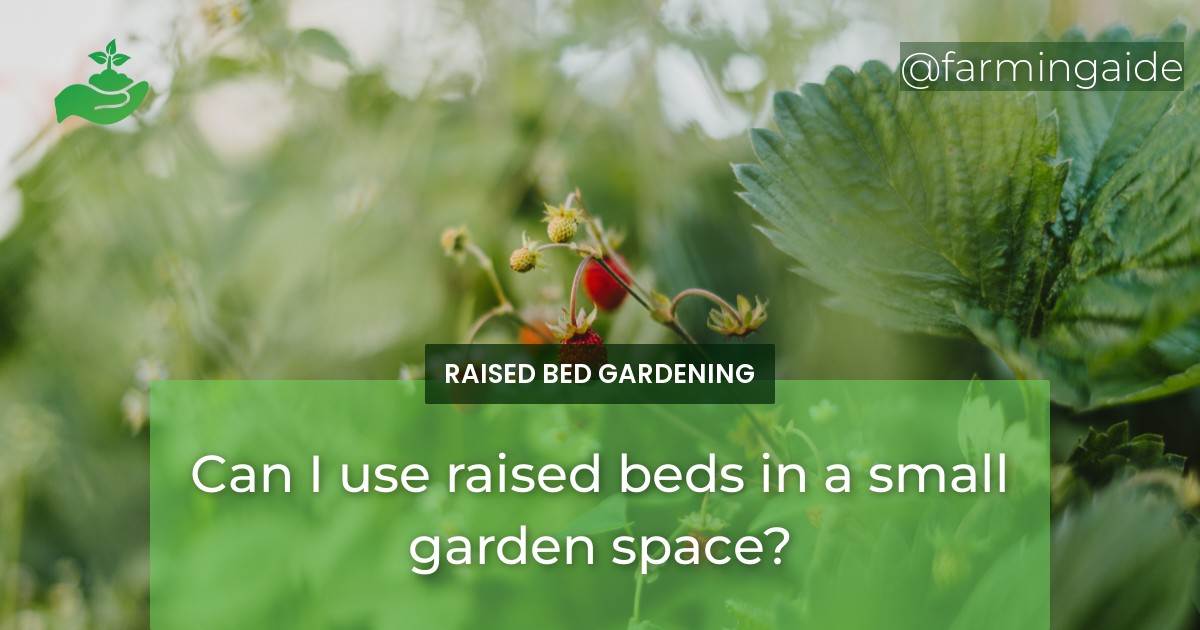Yes, raised beds are an excellent option for small garden spaces. In fact, they are a great solution for gardeners who have limited space to grow plants. Raised beds offer several benefits that make them an ideal choice for gardeners, including efficient use of space, improved soil quality, better drainage, and easier weed control.
Benefits of Raised Bed Gardening
Efficient Use of Space
Raised beds are an excellent way to maximize the use of limited space. By using raised beds, you can plant more crops in a smaller area than you would be able to in a traditional garden. This is because raised beds allow you to plant crops closer together and take advantage of vertical space.
Improved Soil Quality
Raised beds allow you to create a growing environment that is tailored to the needs of your plants. By adding compost, manure, and other organic matter to the soil in your raised beds, you can improve soil quality and provide your plants with the nutrients they need to thrive.
Better Drainage
Raised beds provide better drainage than traditional gardens. This is because the soil in raised beds is elevated above ground level and is not compacted by foot traffic or heavy machinery. As a result, water can drain away more easily, reducing the risk of waterlogging and root rot.
Easier Weed Control
Raised beds make it easier to control weeds. This is because weeds are less likely to grow in the loose, aerated soil of raised beds. Additionally, the elevated nature of raised beds means that you do not have to bend down as far to remove weeds, making the process less strenuous on your back.
Creating Raised Beds in Small Spaces
Choosing the Right Location
The first step in creating raised beds in a small garden space is to choose the right location. You want to choose a spot that gets plenty of sunlight and is relatively flat. Additionally, you may want to consider placing your raised beds near a water source, such as a hose bib or rain barrel.
Sizing and Spacing
The size and spacing of your raised beds will depend on the size of your garden space and the crops you want to grow. As a general rule, raised beds should be no wider than 4 feet, as this allows you to reach all the plants without stepping into the bed. Additionally, you should leave at least 18 inches between each bed to allow for easy access and maintenance.
Building Materials and Options
When it comes to building raised beds, there are several materials and options to choose from. Some popular materials include wood, cinder blocks, and galvanized metal. Regardless of the material you choose, make sure it is sturdy enough to support the weight of the soil and plants.
ALSO READ
Ideal Plants for Raised Beds in Small Gardens
Vegetables and Herbs
Raised beds are an ideal growing environment for vegetables and herbs. Some popular crops to grow in raised beds include tomatoes, peppers, lettuce, kale, and basil.
Flowers and Ornamentals
Raised beds are also a great option for growing flowers and ornamentals. Some popular choices include marigolds, zinnias, and petunias.
Fruits and Berries
Raised beds can also be used to grow fruits and berries, such as strawberries and raspberries. Just make sure you choose a variety that is suited to your climate and growing conditions.
Care and Maintenance of Raised Beds
Watering and Fertilization
Regular watering and fertilization are essential to the health of your plants in raised beds. Make sure to water your plants deeply and regularly, and fertilize them with a balanced fertilizer every few weeks.
Mulching and Composting
Mulching and composting are also important for the health of your plants. Mulching helps retain moisture in the soil and suppress weeds, while composting provides organic matter and nutrients to the soil.
Pest and Disease Control
Finally, it is important to take steps to control pests and diseases in your raised beds. This can include using natural pest control methods, such as companion planting and crop rotation, as well as using organic fungicides and insecticides when necessary.
ALSO READ
Tips for Successful Raised Bed Gardening in Small Spaces
Crop Rotation
Rotating your crops from year to year can help reduce the risk of pests and diseases and improve soil health.
Companion Planting
Planting complementary crops together can help improve soil health and deter pests.
Vertical Gardening Techniques
Using trellises, cages, and other vertical gardening techniques can help maximize space in your raised beds.
Can I use raised beds to maximize space in a small garden?
Yes, converting existing garden raised bed into raised beds can definitely help maximize space in a small garden. By utilizing raised beds, you can grow more plants in a smaller area and make the most of the available space. Plus, they also provide better drainage and soil control.
Conclusion
The Advantages of Using Raised Beds in Small Gardens
Raised beds are an excellent option for gardeners who have limited space to grow plants. They offer several benefits, including efficient use of space, improved soil quality, better drainage, and easier weed control.
The Potential for Abundant Crops and Beautiful Gardens
By following the tips and techniques outlined in this article, you can create a thriving raised bed garden in even the smallest of spaces. Whether you want to grow vegetables, herbs, flowers, or fruits, raised beds are a versatile and effective option for gardeners of all levels of experience.


